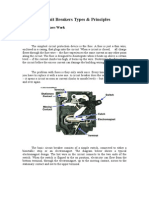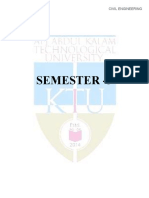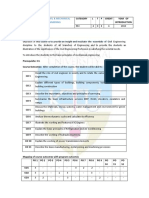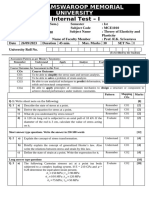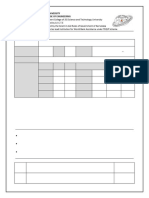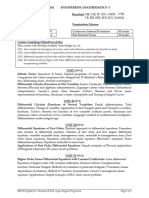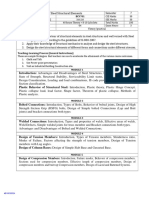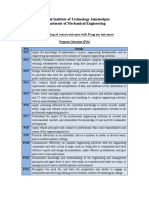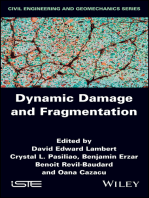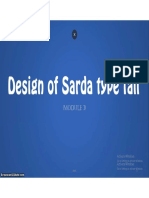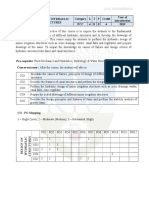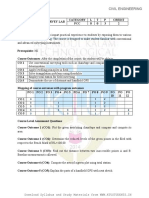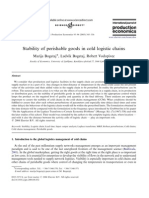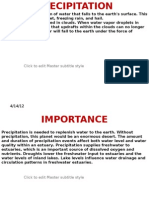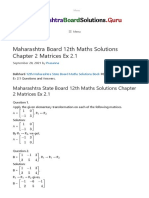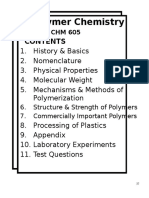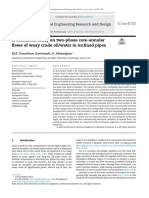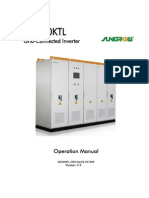CET201 Syllabus
CET201 Syllabus
Uploaded by
dipinnediyaparambathCopyright:
Available Formats
CET201 Syllabus
CET201 Syllabus
Uploaded by
dipinnediyaparambathCopyright
Available Formats
Share this document
Did you find this document useful?
Is this content inappropriate?
Copyright:
Available Formats
CET201 Syllabus
CET201 Syllabus
Uploaded by
dipinnediyaparambathCopyright:
Available Formats
CIVIL ENGINEERING
Year of
MECHANICS OF CATEGORY L T P CREDIT
CET201 Introduction
SOLIDS
PCC 3 1 0 4 2019
Preamble:
Mechanics of solids is one of the foundation courses in the study of structural systems. The
course provides the fundamental concepts of mechanics of deformable bodies and helps
students to develop their analytical and problem solving skills. The course introduces
students to the various internal effects induced in structural members as well as their
deformations due to different types of loading. After this course students will be able to
determine the stress, strain and deformation of loaded structural elements.
Prerequisite: EST 100 Engineering Mechanics
Course Outcomes: After the completion of the course the student will be able to
Course Prescribed
Description of Course Outcome
Outcome learning level
Recall the fundamental terms and theorems associated with
CO1 Remembering
mechanics of linear elastic deformable bodies.
Explain the behavior and response of various structural
CO2 Understanding
elements under various loading conditions.
Apply the principles of solid mechanics to calculate internal
stresses/strains, stress resultants and strain energies in
CO3 Applying
structural elements subjected to axial/transverse loadsand
bending/twisting moments.
Choose appropriate principles or formula to find the elastic
CO4 constants of materials making use of the information Applying
available.
Perform stress transformations, identify principal planes/
CO5 stresses and maximum shear stress at a point in a structural Applying
member.
Analyse the given structural member to calculate the safe
CO6 Analysing
load or proportion the cross section to carry the load safely.
Download Syllabus and Study Materials from WWW.KTUSTUDENTS.IN
CIVIL ENGINEERING
Mapping of course outcomes with program outcomes (Minimum requirement)
PO1 PO2 PO3 PO4 PO5 PO6 PO7 PO8 PO9 PO10 PO11 PO12
CO1 1 - - - - - - - - - - -
CO2 2 1 - - - - - - - - - -
CO3 3 2 - - - - - - - - - -
CO4 3 2 - - - - - - - - - -
CO5 3 2 - - - - - - - - - -
CO6 3 3 1 - - - - - - - - -
Assessment Pattern
Continuous Assessment
Bloom’s Category Tests End Semester Examination
1 2
Remember 10 10 15
Understand 10 10 15
Apply 30 20 60
Analyse 10 10
Evaluate
Create
Mark distribution
Total ESE
CIE ESE
Marks Duration
150 50 100 3 hours
Continuous Internal Evaluation Pattern:
Attendance : 10 marks
Continuous Assessment Test (2 numbers) : 25 marks
Assignment/Quiz/Course project : 15 marks
End Semester Examination Pattern: There will be two parts; Part A and Part B. Part A
contain 10 questions with 2 questions from each module, having 3 marks for each question.
Students should answer all questions. Part B contains 2 questions from each module of which
student should answer any one. Each question carries 14 marks and can have maximum 2
sub-divisions.
Download Syllabus and Study Materials from WWW.KTUSTUDENTS.IN
CIVIL ENGINEERING
Course Level Assessment (Sample) Questions
CO1: Recall the fundamental terms and theorems associated with mechanics of
linear elastic deformable bodies.
1. What is proportionality limit? What is its significance?
2. Sketch the stress-strain curve of mild steel and mark the salient points
3. What is Poisson’s ratio?
4. What is Bulk modulus of Elasticity? Write the relationship between Bulk
modulus of elasticity and Young’s modulus of elasticity.
5. What is pure bending? Give an example.
6. What is point of contraflexure?
7. What are the limitations of Euler’s formula to calculate the buckling load of
slender columns.
8. What is strain energy?
9. What is complementary shear stress?
10. What are principal stresses and principal planes?
CO2: Explain the behavior and response of various structural elements under
various loading conditions.
1. Explain how the deformation of an axially loaded bar with uniformly varying
cross section is calculated?
2. Explain the behavior of mild steel under gradually increasing tensile load.
3. Explain the effect of temperature change on a composite bar made of two
materials.
4. How do you compute the maximum stress induced in a bar due to impact
load?
5. Explain the concept of BM and SF in beams, with the help of a cantilever
beam subjected to uniformly distributed load over the whole span.
6. List three important assumptions used in the theory of pure bending and
explain their significance.
7. Explain the behavior of slender columns under axial compressive load.
8. Distinguish between short and long columns with reference to their behavior
under axial compression.
9. Explain how the limitation of Euler’s formula to calculate buckling load of
columns is addressed in Rankine’s formula.
Download Syllabus and Study Materials from WWW.KTUSTUDENTS.IN
CIVIL ENGINEERING
CO3: Apply the principles of solid mechanics to calculate internal stresses/strains,
stress resultants and strain energies in structural elements subjected to
axial/transverse loads and bending/twisting moments.
1. A steel flat of cross section 25 mm × 6 mm carries a tensile load of 12 kN. Find
the stress induced in the cross section. If a circular hole of diameter 12 mm is
made (normal to the flat surface), find the maximum stress induced in the cross
section.
2. The bar ABC shown in figure is made of steel and has circular cross section. The
bar BD is rigid. Find the stresses in portions AB and BC and the vertical
deflection at C. Take E = 210 GPa.
A
20 mm φ
80 cm
75 cm 60 cm
B D
20 kN
60 cm Rigid
10 mm φ
C
10 kN
3. A rigid barABof length 100 cm, hinged at one end is supported by a steel rod and
a copper wire as shown. Find the stresses induced in the rod and wire due to a
downward load acting at 70 cm from the hinged end of the bar. Calculate the
vertical deflection at B also. Modulus of elasticity of steel and copper are 200 GPa
and 80 GPa respectively. Neglect the weight of the rigid bar.
Copper wire
(2 mm φ& 30 cm long)
A Rigid bar
B
40 cm 30 cm 30 cm
Steel rod
500 N
(6 mm φ& 20 cm long)
Download Syllabus and Study Materials from WWW.KTUSTUDENTS.IN
CIVIL ENGINEERING
4. A 32 mm diameter steel bar is subjected to forces as shown in figure. Find the
value of P necessary for equilibrium and stresses in different segments. Also
calculate the final length of the bar. Take E = 200 GPa.
20 kN 50 kN P 10 kN
0.75 m 1. 5 m 1. 25 m
4. A cylindrical bar with two sections of lengths 50 cm and 25 cm, and diameters 20
mm and 15 mm respectively is subjected to an axial pull such that the maximum
stress is 150MN/m2. Calculate the strain energy stored in the bar. E=200GN/m 2
5. Draw the SFD and BMD of the beam shown.
30 kN
15 kN
10 kN/m
2m 1m 1m
6. Figure shows the cross section of a beam. Find the stresses (both magnitude and
nature) at points A,B,C,D,E and F, if the section carries a BM of 12 kNm. Draw
the variation of stress across the cross section.
Also calculate the shear stress at these points if the cross section carries a SF of 50
kN.
A B
C 40 mm
80 mm
D 40 mm
60 mm
80 mm E
F 20 mm
100 mm
CO4: Choose appropriate principles or formula to find the elastic constants of
materials making use of the information available.
1. A concrete cylinder of diameter 150 mm and height 300 mm is tested under
compression. It was found that the diameter was increased by 0.0102 mm and the
height was decreased by 0.165 mm under the action of a compressive load of 200
kN. Calculate the modulus of elasticity, Poisson’s ratio, bulk modulus and shear
modulus of concrete.
Download Syllabus and Study Materials from WWW.KTUSTUDENTS.IN
CIVIL ENGINEERING
2. A tension test is carried out on a mild steel bar of 10 mm diameter. The bar yields
under a load of 20 kN, it reaches a maximum load of 40 kN and breaks at 25 kN.
The diameter of the bar at breaking was found to be 7 mm. The increase in length of
the bar over a gauge length of 50 mm was found to be 0.029 mm under a load of 10
kN. Estimate (a) Young’s modulus, (b) yield strength, (c) ultimate strength and (d)
actual breaking strength
CO5: Perform stress transformations, identify principal planes/stresses and
maximum shear stress at a point in a structural member.
1. A bar of 12 mm diameter carries an axial pull of 15 kN. Find the normal and
shear stress on a plane inclined at 60° with the axis of the bar. What is the
maximum shear stress induced in the bar and the inclination of the corresponding
plane?
2. At a certain point in a strained material, the stresses on two planes at right angles
to each other are 50 MPa (tensile) and 80 MPa (compressive). They are
accompanied by a shear stress of magnitude 20 MPa. Find the principal stresses
and locate their planes. Also find the maximum shear stress and resultant stress
on the plane of maximum shear stress.
CO6: Analyse the given structural member to calculate the safe load or proportion
the cross section to carry the load safely.
1. A timber beam 150 mm × 200 mm is used as a simply supported beam of span 3
m. Find the maximum uniformly distributed load that can be applied in addition
to a concentrated load of 5 kN acting at the mid span, if the maximum bending
stress in the beam is not to exceed 8 N/mm2. Neglect self weight of beam.
2. A 3 m long cantilever beam of rectangular section is required to carry a udl of 10
kN/m over the whole span. If the maximum bending stress is limited to 12
N/mm2, find the dimensions of the cross section assuming depth to width ratio as
2.
3. A cast iron test beam 25 mm square in section and 700 mm long is simply
supported at ends. It fails under a central load of 2300 N. What load at the free
end will break a cantilever of the same material 50 mm wide × 100 mm deep and
1500 mm long?
4. A solid circular shaft transmits 80 kW power at 190 rpm. Calculate the diameter of the
shaft if the twist in the shaft is not to exceed 1 ° in 2 m length of shaft and shear stress is
limited to 60 MPa. Take G = 100 GPa.
Download Syllabus and Study Materials from WWW.KTUSTUDENTS.IN
CIVIL ENGINEERING
SYLLABUS
Module – 1
Review of statics, Concept of stress and strain – types, Stress – strain relation - Hooke’s law,
Young’s modulus of elasticity.
Stress-strain diagram of mild steel.
Factor of safety, working stress.
Axially loaded bars with uniform cross section–stress, strain and deformation.
Deformation of axially loaded bars with varying cross section and bars with varying axial loads.
Statically indeterminate systems (number of unknowns restricted to two).
Module – 2
Temperature effects, temperature stress in composite bars.
Shear stress and shear strain, Modulus of rigidity, simple shear, punching shear.
Lateral strain, Poisson’s ratio,volumetric strain.
Bulk modulus of elasticity, relationships between elastic constants.
Strain energy – concept.Strain energy due to normal stress.
Strain energy in bars carrying axial loads.
Instantaneous stress in bars due to gradual, sudden and impact loads.Strain energy due to shear stress.
Stresses in thin cylinders and spheres due to internal pressure.
Module – 3
Beams – different types. Types of loading on beams. Concept of bending moment and shear force.
Relationship between intensity of load, shear force and bending moment.
Shear force and bending moment diagrams of cantilever beams, simply supported beams and
overhanging beams for different type of loads. Point of contraflexure.
Module – 4
Theory of simple bending, assumptions and limitations.
Calculation of normal stress in beams, moment of resistance
Shear stress in beams.
Beams of uniform strength.
Strain energy due to bending – calculation of strain energy in beams.
Differential equation for calculating the deflection of beams. (Introduction and demonstration only.
Students are not expected to solve deflection problems.)
Module – 5
Stresses on inclined sections for uniaxial and biaxial stress fields.
Principal stresses and principal planes in 2D problems, maximum shear stress.
Strains along principal directions.
Mohr’s circle of stress for 2D problems.
Short columns – direct and bending stress. Kern of a section.
Slender columns – Euler’s buckling load, slenderness ratio, limitation of Euler’s formula.
Rankines formula.
Torsion of circular and hollow circular shafts, Power transmitted by circular shafts and hollow
circular shafts.Strain energy due to torsion.
Download Syllabus and Study Materials from WWW.KTUSTUDENTS.IN
CIVIL ENGINEERING
Text Books:
1. H. J. Shah andS. B. Junnarkar, Mechanics of Structures Vol - I, Charotar Publishing
House.
2. R. K. Bansal, A Text book of Strength of Materials, Laxmi Publications (P) Ltd, New
Delhi.
3. B. C. Punmia, Ashok K. Jain, Arun Kumar Jain, Mechanics of Materials, Laxmi
Publications (P) Ltd, New Delhi.
References:
1. Egor P. Popov, Engineering Mechanics of Solids, Prentice Hall International Series.
2. James M Gere, S.P. Timoshenko, Mechanics of Materials, CBS Publishers and
Distributors, New Delhi.
3. R.C. Hibbeler, Mechanics of Materials (edn.10), Pearson
4. S. Ramamrutham and R. Narayanan, Strength of Materials, Dhanpat Rai Publishing
Co (P) Ltd.
5. Rattan, Strength of Materials, McGraw Hill Education India.
Lecture Plan –Mechanics of Solids
Course
No. of
Module Topic Outcomes
Lectures
addressed
1 Module I : Total lecture hours : 8
1.1 Review of statics – equilibrium conditions, free body diagrams,
- 1
centroid, moment of inertia.
1.2 Concept of stress, types of stresses. Concept of strain ,types of CO1,
strains. Stress – strain relation - Hooke’s law, Young’s modulus CO2, 1
of elasticity. CO4
1.3 Stress-strain (𝜎 − 𝜀 ) diagram of mild steel – proportional limit,
yield point, ultimate stress, fracture. True and engineering 𝜎 − 𝜀 CO1,
1
curve, idealized 𝜎 − 𝜀 curves. CO2
Factor of safety, working stress.
1.4 Axially loaded bars with uniform cross section– calculation of CO2,
1
stress, strain and deformation. CO3
1.5 Deformation of axially loaded bars with varying cross section.
CO3 1
Stepped bars, bars with tapering cross section
1.6 Deformation of axially loaded bars with varying axial loads –
elongation of bars under self weight, elongation/contraction of CO3 1
uniform/stepped bars.
1.7 Statically indeterminate systems – analysis of axially loaded CO3,
composite bars (with maximum two materials) 1
CO6
1.8 Analysis of indeterminate systems with axial load carrying
CO3,
members (number of unknowns restricted to two). 1
CO6
(Example: Assessment Level Question 3 of CO3)
Download Syllabus and Study Materials from WWW.KTUSTUDENTS.IN
CIVIL ENGINEERING
2 Module II : Total lecture hours : 8
2.1 Temperature effects, temperature stress in composite bars. CO2,
1
CO3
2.2 Shear stress and shear strain, Modulus of rigidity, simple shear, CO1, CO2,
1
punching shear. CO3, CO4
2.3 Lateral strain, Poisson’s ratio, volumetric strain.
Volumetric strain of rectangular bar, circular bar and sphere. CO2,
1
Volumetric strain expressed in terms of strains along three CO3
mutually perpendicular directions.
2.4 Bulk modulus of elasticity, relationships between elastic CO1,
1
constants. CO4
2.5 Strain energy – concept. Resilience, modulus of resilience and
proof resilience.
CO1,CO2,
Strain energy due to normal stress.Calculation of total strain 2
CO3
energy in bars carrying axial loads.
Strain energy due to shear stress.
2.6 Instantaneous stress in bars due to gradual, sudden and impact CO1,CO2,
1
loads. CO3
2.7 Stresses in thin cylinders and spheres due to internal pressure CO1, CO2,
1
CO3
3 Module III : Total lecture hours : 8
3.1 Beams – different types. Types of loading on beams. Concept of
CO1,
bending moment and shear force. Shear force and bending 1
CO2
moment diagrams.
3.2 Relationship between load, shear force and bending moment.
CO1 1
Demonstration using simple examples.
3.3 Shear force and bending moment diagrams of cantilever beams
subjected to point load, concentrated moments, uniformly CO2 2
distributed and uniformly varying loads.
3.4 Shear force and bending moment diagrams of simply supported
beams subjected to point load, concentrated moment, uniformly CO2 2
distributed and uniformly varying loads.
3.5 Shear force and bending moment diagrams of overhanging beams
CO1,
subjected to point load, concentrated moment and uniformly 2
distributed loads. Point of contraflexure. CO2
4 Module IV : Total lecture hours : 9
4.1 Theory of simple bending – derivation of equation, assumptions CO1,
and limitations. 1
CO2
4.2 Variation of bending stress across the cross section.
CO1,
Maximum bending stress, section modulus, moment of 1
CO2
resistance.
4.3 Calculation of normal stress in beams.
Problems involving bending stress CO3 1
Download Syllabus and Study Materials from WWW.KTUSTUDENTS.IN
CIVIL ENGINEERING
4.4 Shear stress in beams – derivation of equation.
Variation of shear stress across the cross section. CO1,
1
(Derivation required for rectangular, circular and triangular CO2
sections only)
4.5 Calculation of shear stress- problems involving shear stress. CO3 1
4.6 Calculation of allowable loads in beams based on bending stress
CO6 1
and shear stress criteria.
4.7 Proportioning beam sections to carry given load without
exceeding the allowable bending stress and/ shear stress. CO6 1
Beams of uniform strength.
4.8 Strain energy due to bending – calculation of strain energy in
CO1,
beams.
CO2, 1
(Cantilever and simply supported beams subjected to point load
CO3
and uniformly distributed load)
4.9 Moment-curvature relation. Basic differential equation for
calculating the deflection of beams.
Simple example to calculate deflection of beams (such as CO1 1
cantilever beam with point load at free end) for demonstration
purpose.
5 Module V : Total lecture hours : 12
5.1 Stresses on inclined planes for uniaxial and biaxial stress fields.
Element subjected to pure shear. CO3 2
5.2 Principal stresses and principal planes in 2D problems, maximum
CO1, CO3,
shear stress. 2
CO5
Strains along principal directions.
5.3 Mohr’s circle of stress for 2D problems. CO3, CO5 1
5.4 Short columns – direct and bending stress. CO1,CO2,
1
Kern of a section (concept only). CO3
5.5 Slender columns –Buckling, Euler’s buckling load for columns
with pinned ends. Eulers’ buckling load for columns with CO1,CO2,
2
different end conditions (no derivation required). Effective length CO3
of columns with different end conditions.
5.6 Slenderness ratio, limitation of Euler’s formula.
CO1,CO2,
Rankine’s formula. Safe load calculation using Rankine’s 1
CO3
formula (demonstration only).
5.7 Torsion of circular and hollow circular shafts, assumptions,
CO1,CO2,
derivation of torsion equation. Variation of stress across the cross 1
CO3
section.Polar modulus.
5.8 Power transmitted by circular shafts and hollow circular shafts.
Proportioning the shafts to transmit a given power based on shear
CO3, CO6 2
stress and angle of twist considerations
Strain energy due to torsion.
10
Download Syllabus and Study Materials from WWW.KTUSTUDENTS.IN
CIVIL ENGINEERING
MODEL QUESTION PAPER
Reg.No.:_______________ Name:__________________________
APJ ABDUL KALAM TECHNOLOGICAL UNIVERSITY
THIRD SEMESTER B.TECH DEGREE EXAMINATION
Course Code: CET201
Course Name: MECHANICS OF SOLIDS
Max. Marks: 100 Duration: 3 Hours
PART A
Answer all questions; each question carries 3 marks.
1. a) Define the terms (i) proportionality limit, (ii) ultimate stress (ii) working stress.
b) Explain, how the deformation of an axially loaded bar with uniformly varying cross section is
calculated?
c) Explain the effect of temperature change on a composite bar made of two materials.
d) What is Bulk modulus of Elasticity? Write the relationship between Bulk modulus of elasticity
and Young’s modulus of elasticity.
e) What is the relationship between intensity of load, SF and BM?
f) Explain the concept of BM and SF in beams, with the help of a cantilever beam subjected to
uniformly distributed load over the whole span.
g) What is pure bending? Give an example.
h) List three important assumptions used in the theory of pure bending and their significance.
i) What are principal stresses and principal planes?
j) Distinguish between short and long columns with reference to their behavior under axial
compression.
(10×3 marks = 30 marks)
PART B
Answer one full question from each module; each full question carries 14 marks.
Module I
2. A bar of circular cross section has three segments as shown in figure. The portion AB has a
constant diameter of 25 mm. The portion BC has diameter 25 mm at B and tapers uniformly
to diameter ‘d ’ at C. The portion CD has a constant diameter of ‘d ’. The bar was found to
elongate by 0.539 mm under an axial tension of 20 kN. Find the value of ‘d ‘. Take Young’s
modulus of elasticity of the material as 200 GPa.
A B
C D
25 mm φ d
400 mm 500 mm 600 mm
11
Download Syllabus and Study Materials from WWW.KTUSTUDENTS.IN
CIVIL ENGINEERING
3. A steel rod of 25 mm diameter is placed in a hollow aluminium cylinder with internal
diameter 30 mm and external diameter 40 mm. The steel rod projects 0.1 mm as shown. The
bar carries a compressive force of 70 kN through a rigid bearing plate. Find the stresses in
steel and aluminium bars. Es = 200 GPa and Eal = 120 GPa
70 kN
0.1 mm
Steel
300 mm 25 mm Aluminium
30 mm
40 mm
Module II
4. A concrete cylinder of diameter 150 mm and height 300 mm is tested under axial
compression. It was found that the diameter was increased by 0.0102 mm and the height
was decreased by 0.165 mm under the action of a compressive load of 200 kN. Calculate
the modulus of elasticity, Poisson’s ratio, bulk modulus and shear modulus of concrete.
5. A compound bar is made of a central steel plate 60 mm wide and 10 mm thick to which
copper plates 40 mm wide and 5mm thick are rigidly connected on each side. The length of
the bar at normal temperature is 1 m. If the temperature is raised by 80oC, determine the
stress in each metal and the change in length. Es = 2×105 N/mm2 ,αS = 12×10-6 /oC, Ec =
1.05×105 N/mm2 and αC = 17.5×10-6 /oC.
Module III
6. Draw the SFD and BMD of the beam loaded as shown in figure. Find the maximum BM
and locate the point of maximum BM also.
10 kN/m 15 kN
1m 3m 1m 1m
7. An overhanging beam is loaded as shown. Draw SFD and BMD. Locate the point of
contraflexure also.
10 kN/m 20 kN
1m 2m 1.5 m 1.5 m
12
Download Syllabus and Study Materials from WWW.KTUSTUDENTS.IN
CIVIL ENGINEERING
Module IV
8. a) A simply supported beam of triangular cross section, having width 160 mm and height
210 mm, carries a udl of 2 kN/m over a span of 4m. Find the maximum tensile and
compressive stresses induced. Draw the variation of stress across the cross section.
(10 marks)
b) Calculate the total strain energy due to bending in a cantilever beam of span L carrying
a point load W at its free end. (4 marks)
9. a) A timber beam 150 mm × 200 mm (width = 150 mm) is used as a simply supported beam of
span 3 m. Find the maximum uniformly distributed load that can be applied in addition to a
concentrated load of 5 kN acting at the mid span, if the maximum bending stress and shear
stress in the beam are not to exceed 15 N/mm2 and 2 N/mm2 respectively. Neglect self weight
of beam. (10 marks)
b) What is beam of uniform strength? Give an example. (4 marks)
Module V
10. A point in a strained body is subjected to stresses as shown in figure. Find the principal
stresses and maximum shear stress. Also locate the principal planes and planes of maximum
shear stress, with respect to the vertical plane. Calculate the strains along the direction of
the principal stresses also. Take E = 200 GPa and = 0.25.
50 MPa
20 MPa
90 MPa
90 MPa
20 MPa
50 MPa
11. A solid circular shaft transmits 80 kW power at 190 rpm. Calculate the diameter of the shaft
if the twist in the shaft is not to exceed 1o in 2 m length of shaft and shear stress is limited to
60 MPa. Take G = 100 GPa.
*********************
13
Download Syllabus and Study Materials from WWW.KTUSTUDENTS.IN
You might also like
- Circuit Breakers TypesDocument42 pagesCircuit Breakers TypesVikas Gupta100% (2)
- Salometer UsageDocument3 pagesSalometer UsageBenjamin Grégoire100% (1)
- Civil Engineering - S3 & S4Document147 pagesCivil Engineering - S3 & S4anushafiNo ratings yet
- ALL-CIVIL ENGINEERING - S3 - 2019-Scheme-Syllabus - Ktu StuDocument67 pagesALL-CIVIL ENGINEERING - S3 - 2019-Scheme-Syllabus - Ktu StuMeghaNo ratings yet
- STRUCTURAL ANALYSIS - Syllabus KtuDocument13 pagesSTRUCTURAL ANALYSIS - Syllabus KtuHarikrishna SNo ratings yet
- CET302 - SyllabusDocument13 pagesCET302 - SyllabusdipinnediyaparambathNo ratings yet
- CET301 - Ktu QbankDocument14 pagesCET301 - Ktu QbankparmodrtkNo ratings yet
- CET301 SA SyllabusDocument13 pagesCET301 SA SyllabusSajeer ModavanNo ratings yet
- CET301 SyllabusDocument13 pagesCET301 SyllabusdipinnediyaparambathNo ratings yet
- Syllabus AutomobileS3MinorDocument95 pagesSyllabus AutomobileS3MinorRenjith BabuNo ratings yet
- Mechanical EngineeringDocument11 pagesMechanical Engineeringhyy5u6No ratings yet
- Mechanics of SolidsDocument11 pagesMechanics of Solidsraseg37567No ratings yet
- MECHANICAL ENGINEERING 2019 Scheme S3 Syllabus Ktustudents - inDocument73 pagesMECHANICAL ENGINEERING 2019 Scheme S3 Syllabus Ktustudents - inNivedNo ratings yet
- s6 Syllabus EiaDocument292 pagess6 Syllabus EiaTHOMASKUTTYNo ratings yet
- CET303 SyllabusDocument11 pagesCET303 SyllabusdipinnediyaparambathNo ratings yet
- s3-s4 Syllabus PDFDocument164 pagess3-s4 Syllabus PDFdanielcribuNo ratings yet
- Basic Civil & Mechanical-2019-Syllabus-Ktustudents - in PDFDocument13 pagesBasic Civil & Mechanical-2019-Syllabus-Ktustudents - in PDFAjeshSomanPulladNo ratings yet
- CET 203 SyllabusDocument12 pagesCET 203 SyllabusdipinnediyaparambathNo ratings yet
- KTU BTech ME 2019scheme 2019Scheme-MinorsDocument114 pagesKTU BTech ME 2019scheme 2019Scheme-MinorsLearn Mechanical EngineeringNo ratings yet
- Basics of Civil & Mechanical EngineeringDocument123 pagesBasics of Civil & Mechanical Engineeringfebin philipNo ratings yet
- EST120 Basic - Civil - & - Mechanical PDFDocument12 pagesEST120 Basic - Civil - & - Mechanical PDFlecim12450No ratings yet
- EST120 Basiccivil&mechanical PDFDocument12 pagesEST120 Basiccivil&mechanical PDFlecim12450No ratings yet
- Semester Vii: Civil EngineeringDocument378 pagesSemester Vii: Civil EngineeringusmanNo ratings yet
- Design of Steel StructuresDocument8 pagesDesign of Steel StructuresNandana RajeevNo ratings yet
- PKK - SE - MOS - 2022-23 - Sem IDocument4 pagesPKK - SE - MOS - 2022-23 - Sem IPrashant ChavanNo ratings yet
- S. G. Balekundri Institute of Technology: Department of Mechanical EngineeringDocument2 pagesS. G. Balekundri Institute of Technology: Department of Mechanical Engineeringvaijanath patilNo ratings yet
- Mce1003p It 1Document2 pagesMce1003p It 1Sid ZainNo ratings yet
- Engg - Mechanics 2019 Syllabus Ktustudents - inDocument13 pagesEngg - Mechanics 2019 Syllabus Ktustudents - inashmerkmNo ratings yet
- Comprehensive Course WorkDocument5 pagesComprehensive Course WorkNandulal KrishnaNo ratings yet
- Category L T P Credit Year ofDocument10 pagesCategory L T P Credit Year ofSAKHI U 20MLCE11No ratings yet
- CM-BCV301Document4 pagesCM-BCV301Antharya N shettyNo ratings yet
- SYLLABUS-S6Document169 pagesSYLLABUS-S6Suraj KumarNo ratings yet
- Met 205Document9 pagesMet 205DrRoja A RNo ratings yet
- Dynamics and Design of MachineryDocument10 pagesDynamics and Design of MachineryBen JoeNo ratings yet
- MECHANICAL (AUTOMOBILE) ENGINEERING - 2019-Scheme-S3-Syllabus - Ktustudents - inDocument44 pagesMECHANICAL (AUTOMOBILE) ENGINEERING - 2019-Scheme-S3-Syllabus - Ktustudents - injishnu unniNo ratings yet
- CEC-303 (Structural Analysis-II)Document2 pagesCEC-303 (Structural Analysis-II)ayush kumarNo ratings yet
- Justification of Engg Mechanics CO-PO MappingDocument2 pagesJustification of Engg Mechanics CO-PO MappingP K JainNo ratings yet
- CET203 - KQB KtuQbankDocument12 pagesCET203 - KQB KtuQbankMuhammed BilalNo ratings yet
- Design of Steel StructuresDocument2 pagesDesign of Steel Structuresdevilrogue5483No ratings yet
- Met304 DDM SyllabusDocument10 pagesMet304 DDM SyllabuselsonpaulNo ratings yet
- S8 Elective V SyllabusDocument21 pagesS8 Elective V SyllabusnafidfdNo ratings yet
- Engineering Physics 24PH110 - 24PH210 - First Year (1st and 2nd Sem) BEDocument5 pagesEngineering Physics 24PH110 - 24PH210 - First Year (1st and 2nd Sem) BEkeerthukeerthi2006No ratings yet
- GEOTECHNICAL ENGINEERING - SyllabusDocument9 pagesGEOTECHNICAL ENGINEERING - SyllabusHarikrishna SNo ratings yet
- Advanced Foundation DesignDocument8 pagesAdvanced Foundation DesignMuhammed T RasheedNo ratings yet
- CHT205 - KQB KtuQbankDocument9 pagesCHT205 - KQB KtuQbanktintubhai27No ratings yet
- Engg Mechanics PDFDocument13 pagesEngg Mechanics PDFVinayakNo ratings yet
- SYLLABUSDocument2 pagesSYLLABUSi Don't knowNo ratings yet
- 4 CivsyllDocument50 pages4 CivsyllCIVIL ENGINEERINGNo ratings yet
- CE3502 SA I QB WITH ANSWERSDocument27 pagesCE3502 SA I QB WITH ANSWERSDhivyalakshmi MNo ratings yet
- EE3512 - C and I Lab Manual-StudentDocument100 pagesEE3512 - C and I Lab Manual-StudentpurushothNo ratings yet
- Structural DynamicsDocument2 pagesStructural Dynamicsmythilispd_355305156No ratings yet
- DR JPS FM Before Mapping - New - FormatDocument5 pagesDR JPS FM Before Mapping - New - Formatdiksha singhNo ratings yet
- P23. Mapping of Course Outcome With Program OutcomesDocument31 pagesP23. Mapping of Course Outcome With Program OutcomesBhaskar MondalNo ratings yet
- CE 1011 - Course ProfileDocument3 pagesCE 1011 - Course Profilemasudmiazi169588No ratings yet
- MTech Structural Engg SyllabusDocument62 pagesMTech Structural Engg SyllabusK C DeneshNo ratings yet
- 3-2 SyllabusDocument17 pages3-2 Syllabus530-M-004 AVINASH SAI GANGADANo ratings yet
- New SyllDocument10 pagesNew Syll530-M-004 AVINASH SAI GANGADANo ratings yet
- CET308 - Ktu QbankDocument9 pagesCET308 - Ktu QbankAkhila MathewNo ratings yet
- 18CEH105 SyllabusDocument2 pages18CEH105 SyllabusVivekanandan RNo ratings yet
- Introduction to Design of Building StructuresFrom EverandIntroduction to Design of Building StructuresRating: 4 out of 5 stars4/5 (22)
- Dynamic Damage and FragmentationFrom EverandDynamic Damage and FragmentationDavid Edward LambertNo ratings yet
- Airport Seaport HarbourDocument8 pagesAirport Seaport HarbourSAKHI U 20MLCE110% (1)
- Project About Construction of Medical CollegeDocument4 pagesProject About Construction of Medical CollegedipinnediyaparambathNo ratings yet
- 03 Cet 404 Comprehensive Course Viva Slot e S8Document1 page03 Cet 404 Comprehensive Course Viva Slot e S8dipinnediyaparambathNo ratings yet
- Construction of New Road Work in Pmgsy StandardDocument1 pageConstruction of New Road Work in Pmgsy StandarddipinnediyaparambathNo ratings yet
- Montague CurveDocument1 pageMontague Curvedipinnediyaparambath100% (2)
- 04 Cet 416 Project Phase Ii Slot U S8Document9 pages04 Cet 416 Project Phase Ii Slot U S8dipinnediyaparambathNo ratings yet
- CE233 Surveying LabDocument1 pageCE233 Surveying LabdipinnediyaparambathNo ratings yet
- Construction of A Compound Villa Complex With InfrastructureDocument4 pagesConstruction of A Compound Villa Complex With InfrastructuredipinnediyaparambathNo ratings yet
- D03 Design of Sarda FallDocument56 pagesD03 Design of Sarda FalldipinnediyaparambathNo ratings yet
- Cet306 Design of Hydraulic Structures SyllabusDocument7 pagesCet306 Design of Hydraulic Structures SyllabusdipinnediyaparambathNo ratings yet
- D05 Design of Cross RegulatorDocument28 pagesD05 Design of Cross RegulatordipinnediyaparambathNo ratings yet
- Amie Section B SyllabusDocument1 pageAmie Section B SyllabusdipinnediyaparambathNo ratings yet
- Blench Curve ADocument1 pageBlench Curve Adipinnediyaparambath50% (2)
- CEL 203 SyllabusDocument4 pagesCEL 203 SyllabusdipinnediyaparambathNo ratings yet
- CET309Document12 pagesCET309dipinnediyaparambathNo ratings yet
- KTUMTechconstructionengineeringmanagement (2015)Document68 pagesKTUMTechconstructionengineeringmanagement (2015)dipinnediyaparambathNo ratings yet
- CET205 SyllabusDocument10 pagesCET205 SyllabusdipinnediyaparambathNo ratings yet
- Cet402 Quantity Surveying and ValuationDocument13 pagesCet402 Quantity Surveying and ValuationdipinnediyaparambathNo ratings yet
- MAT 201 SyllabusDocument8 pagesMAT 201 SyllabusdipinnediyaparambathNo ratings yet
- CET 307 SyllabusDocument12 pagesCET 307 SyllabusdipinnediyaparambathNo ratings yet
- 05 10 21 Engineering Geology CET 202 SyllabusDocument7 pages05 10 21 Engineering Geology CET 202 SyllabusdipinnediyaparambathNo ratings yet
- CET 203 SyllabusDocument12 pagesCET 203 SyllabusdipinnediyaparambathNo ratings yet
- Civil Engineering: Year ofDocument4 pagesCivil Engineering: Year ofdipinnediyaparambathNo ratings yet
- Civil Engineering: Geotechnical Engineering LAB Category L T P Credit Year of PCC 0 0 3 2 2019Document3 pagesCivil Engineering: Geotechnical Engineering LAB Category L T P Credit Year of PCC 0 0 3 2 2019dipinnediyaparambathNo ratings yet
- Civil Engineering: Category L T P Credit Year ofDocument8 pagesCivil Engineering: Category L T P Credit Year ofdipinnediyaparambathNo ratings yet
- The Institution of Engineers (India) : (For Member Technologist Applicants)Document8 pagesThe Institution of Engineers (India) : (For Member Technologist Applicants)dipinnediyaparambathNo ratings yet
- CET303 SyllabusDocument11 pagesCET303 SyllabusdipinnediyaparambathNo ratings yet
- Allotment of Proj Guide Lab ExpDocument376 pagesAllotment of Proj Guide Lab ExpdipinnediyaparambathNo ratings yet
- Civil Engineering: Category L T P Credit Year ofDocument4 pagesCivil Engineering: Category L T P Credit Year ofdipinnediyaparambathNo ratings yet
- CET301 SyllabusDocument13 pagesCET301 SyllabusdipinnediyaparambathNo ratings yet
- Negligible Crack Growth Thresholds: Lyndon Lamborn, Greg Nelson, James HarterDocument9 pagesNegligible Crack Growth Thresholds: Lyndon Lamborn, Greg Nelson, James HarterZaimatul SulfizaNo ratings yet
- Experiment 08 Simple PendulumDocument8 pagesExperiment 08 Simple PendulumAnonymous rswF6CNo ratings yet
- Energy Audit-SYLLABUSDocument4 pagesEnergy Audit-SYLLABUSHariprasath SelvakumarNo ratings yet
- Dairy Scm5Document12 pagesDairy Scm5sahanareNo ratings yet
- Faculty Recruitment Test: Category-D (Chemistry) Paper - ADocument2 pagesFaculty Recruitment Test: Category-D (Chemistry) Paper - AAkshit MalhotraNo ratings yet
- Click To Edit Master Subtitle StyleDocument11 pagesClick To Edit Master Subtitle StylepallavisoniNo ratings yet
- Science Quiz Bee 2015Document39 pagesScience Quiz Bee 2015Jonas Miranda Cabusbusan100% (1)
- Material Balance Ammonium SulphateDocument3 pagesMaterial Balance Ammonium SulphateAnkush singhNo ratings yet
- 936 PDFDocument67 pages936 PDFAnonymous lmCR3SkPrKNo ratings yet
- S.S. Bhavikatti - Finite Element Analysis-New Age Publications (Academic) (2004) - 232-253Document27 pagesS.S. Bhavikatti - Finite Element Analysis-New Age Publications (Academic) (2004) - 232-253Gokul KNo ratings yet
- Maharashtra Board 12th Maths Solutions Chapter 2 Matrices Ex 2.1Document6 pagesMaharashtra Board 12th Maths Solutions Chapter 2 Matrices Ex 2.1rohit100% (2)
- Anneuxe 5.1-Drain Design - Calculation-A 05 Lined Rectangular DrainDocument2 pagesAnneuxe 5.1-Drain Design - Calculation-A 05 Lined Rectangular Draintripvietnam700No ratings yet
- Matri MandirDocument8 pagesMatri Mandirchetna mudgalNo ratings yet
- How To Control The Warping of Parts in Thin SheetDocument6 pagesHow To Control The Warping of Parts in Thin SheetNeil WayneNo ratings yet
- CBR Solid State. Nia-Noni-Rionaldo - Bilingual Phy 17Document19 pagesCBR Solid State. Nia-Noni-Rionaldo - Bilingual Phy 17Nia Audina SitanggangNo ratings yet
- Polymer Notes 2014 Parts 5-7Document103 pagesPolymer Notes 2014 Parts 5-7RadhiNo ratings yet
- Math 2ND Year Guess AlpDocument18 pagesMath 2ND Year Guess AlpMohammad AshfaqNo ratings yet
- Chang Chap 1 BB PDFDocument35 pagesChang Chap 1 BB PDFMR no oneNo ratings yet
- SamplingDocument13 pagesSamplingravikumar rayalaNo ratings yet
- 1 s2.0 S0263876220301696 MainDocument15 pages1 s2.0 S0263876220301696 MainSayan HalderNo ratings yet
- Synthesis of Silver Nanoparticles - Chemical, Physical and Biological MethodsDocument27 pagesSynthesis of Silver Nanoparticles - Chemical, Physical and Biological MethodsAndrea CalderaNo ratings yet
- Product Configuration: 10.11.2016 Test Project / 822 - Test Project PDFDocument2 pagesProduct Configuration: 10.11.2016 Test Project / 822 - Test Project PDFvictordraghiciuNo ratings yet
- Distribution System Planning With Distributed Thermal and Wind GenerationDocument6 pagesDistribution System Planning With Distributed Thermal and Wind GenerationLORENNANo ratings yet
- Modelling and Control of Ball and Beam System Using PID ControllerDocument6 pagesModelling and Control of Ball and Beam System Using PID ControllerTới Hồ VănNo ratings yet
- Invertor 500 KW SG500KTLDocument62 pagesInvertor 500 KW SG500KTLdorcioNo ratings yet
- Datasheet 593356 (98-8970) enDocument12 pagesDatasheet 593356 (98-8970) enLuis Ramirez CNo ratings yet
- St7018 Stability of Structures L T P CDocument1 pageSt7018 Stability of Structures L T P Camma83233% (6)
- Keyway and Effect of KeywayDocument3 pagesKeyway and Effect of KeywayHardik ParmarNo ratings yet
